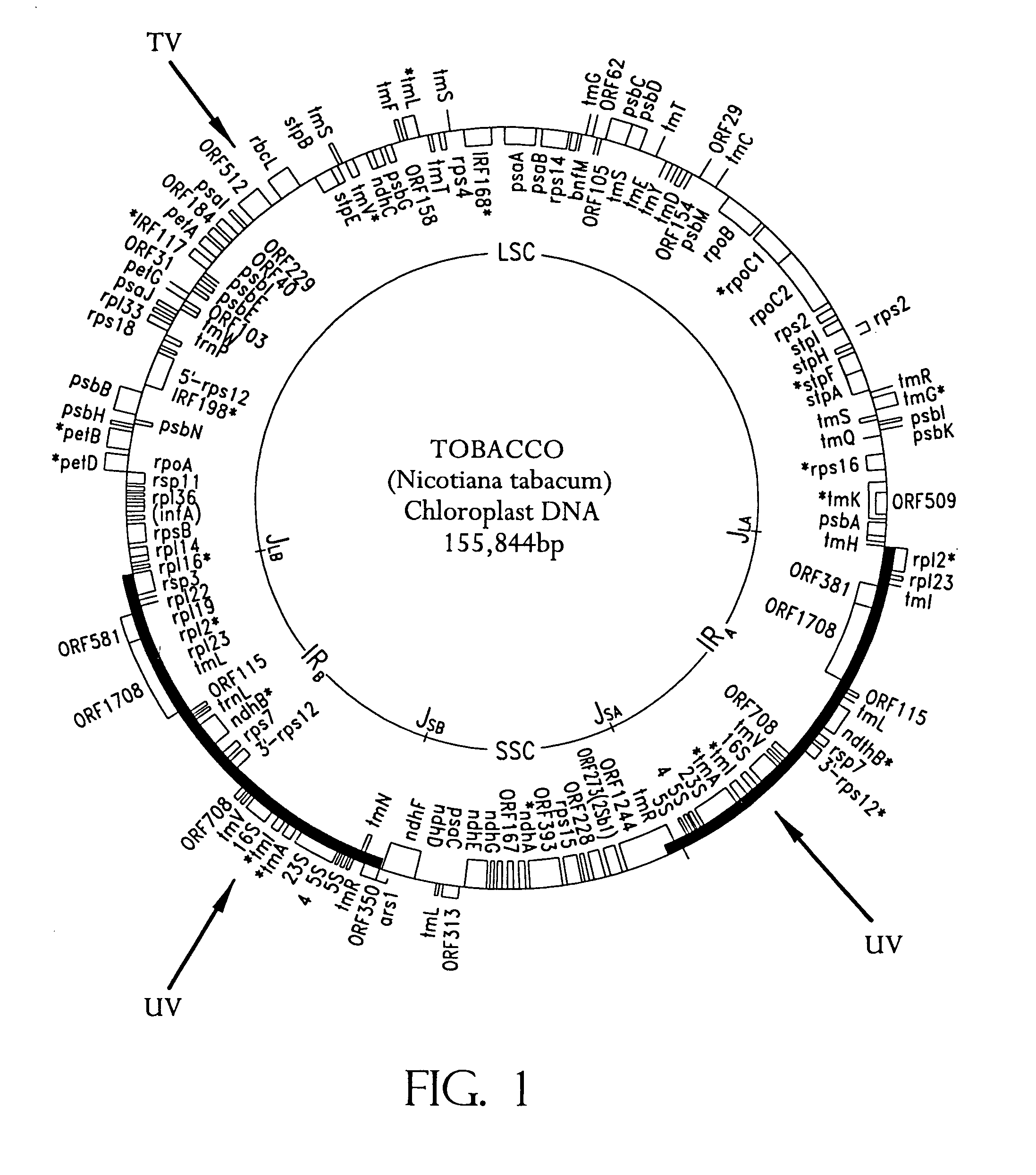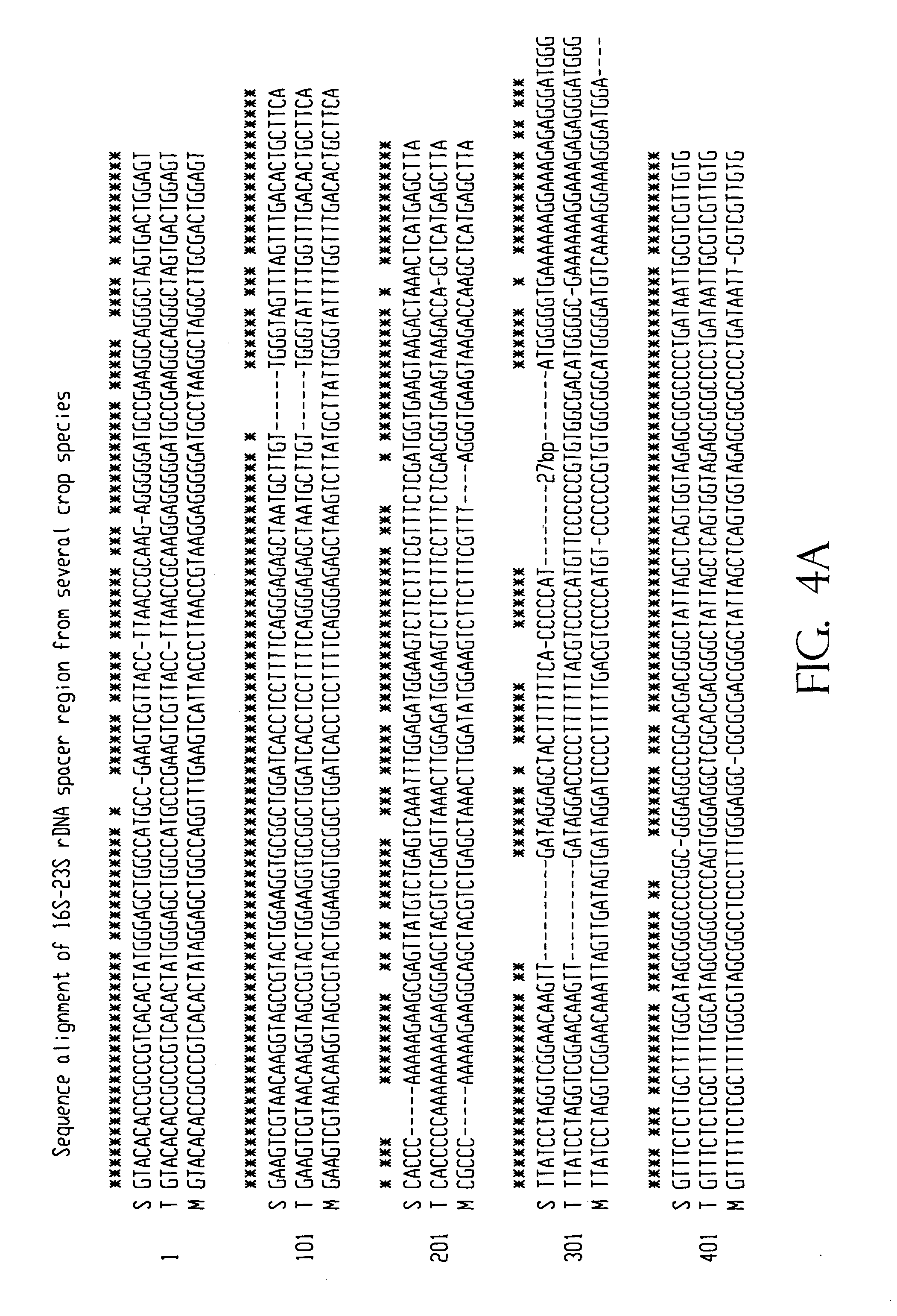Universal chloroplast integration and expression vectors, transformed plants and products thereof
a technology of expression vectors and chloroplasts, applied in biochemistry, sugar derivatives, organic chemistry, etc., can solve the problem of low degree of homology between species of spacer regions, and achieve the effect of higher growth rate and higher growth rate of
- Summary
- Abstract
- Description
- Claims
- Application Information
AI Technical Summary
Benefits of technology
Problems solved by technology
Method used
Image
Examples
example 1
Universal Chloroplast Integration and Expression Vectors
[0158]Tobacco. Exemplary universal chloroplast vectors were constructed by first cutting out the tobacco chloroplast DNA BamHI fragment (130656-140992) containing the 16S and 23S rRNA genes and subcloning it into a commonly available bacterial plasmid pUC19. A map of the tobacco chloroplast genome is shown in FIG. 1. A 2.1 kbp HindIII-EcoRI fragment present within this fragment, containing a universal border sequence comprising trnI and trnA genes (FIG. 5A), including the spacer region between the genes, was subcloned into the pUC19 plasmid at the PvuII site (FIG. 5B). The resultant plasmid was designated pSBL-Ct Bor (FIG. 5C).
[0159]The vector pSBL-RD-EPSPS (FIG. 2B) contains a mutant EPSP synthase gene that codes for the enzyme EPSP synthase. Glyphosate, the active ingredient in Mosanto's ROUND UP™, binds to the protein EPSP synthase and blocks the synthesis of essential amino acids, resulting in death of a plant. The EPSP syn...
example 2
[0165]Chloroplast Transformation of Tobacco. The following example describes a classic protocol for transformation of tobacco chloroplast for which any vector can be used. Two such vectors are identified below. All new chloroplast vectors were first tested in tobacco as described in Daniell, (1997). Tobacco (Nicotiana tabacum var. Petit Havana) plants were grown aseptically by germination of seeds on MSO medium containing MS salts (4.3 g / liter), B5 vitamin mixture (myo-inositol, 100 mg / liter; thiamine-HCl, 10 mg / liter; nicotinic acid, 1 mg / liter; pyridoxine-HCl, 1 mg / liter), sucrose (30 g / liter) and phytagar (6 g / liter) at pH 5.8. Fully expanded green leaves of about two month old plants were selected for bombardment.
[0166]Leaves were placed abaxial side up on a Whatman No. 1 filter paper laying on RMOP* medium in standard Petri plates (100×15 mm) for bombardment. Tungsten (1 μm) or Gold (0.6 μm) microprojectiles were coated with plasmid DNA, of interest (e.g. PSBL-RD-EPSPS or pZS-R...
example 3
[0170]Corn Chloroplast Transformation. Surface sterilization and germination of corn seeds. Corn seeds are surface sterilized in a solution containing 20% (v / v) commercial bleach and 0.5% SDS for 15 min under continuous shaking, then serially rinsed in sterile double-distilled water (sddw) four to five times. Liquid MS-based germination medium (modified CSG) containing MS salts (4.3 g / l), sucrose (30 g / l), DM-vitamins (1.0 mg / l thiamine-HCl, 0.5 mg / l nicotinic acid, 0.5 mg / l pyridoxine-HCl and 100 mg / l myo-inositol) and BA (2.0 mg / l) at pH 5.8 is dispensed per Magenta™ box (45 ml) containing eight layers of cheesecloth, then autoclaved. Seeds are placed in modified CSG (25 seeds of any genotype per box) and cultured for three days (16 h or continuous light; 25C) for germination. Nodal sections are excised aseptically from three day-old seedlings. The nodal section appears as a clear demarcation on the germinating seedling and represents the seventh node (FIG. 10A). When excised, the...
PUM
| Property | Measurement | Unit |
|---|---|---|
| Electrical conductance | aaaaa | aaaaa |
| Electrical conductance | aaaaa | aaaaa |
| Electrical resistance | aaaaa | aaaaa |
Abstract
Description
Claims
Application Information
 Login to View More
Login to View More - R&D
- Intellectual Property
- Life Sciences
- Materials
- Tech Scout
- Unparalleled Data Quality
- Higher Quality Content
- 60% Fewer Hallucinations
Browse by: Latest US Patents, China's latest patents, Technical Efficacy Thesaurus, Application Domain, Technology Topic, Popular Technical Reports.
© 2025 PatSnap. All rights reserved.Legal|Privacy policy|Modern Slavery Act Transparency Statement|Sitemap|About US| Contact US: help@patsnap.com



